Wideband Performance Comparison between the 40 GHz and 60 GHz Frequency Bands for Indoor Radio Channels
Abstract
:1. Introduction
2. Materials and Methods
2.1. Measurement Setup and Procedure
2.2. Measurement Environments
2.3. Data Processing
2.4. Ray-Tracing Analysis
3. Results
3.1. Auditorium
3.2. Corridor
4. Discussion
- The amount of multipath contributions is clearly reduced in 60 GHz compared to 40 GHz. This is due to the larger propagation attenuation and lower reflection coefficients at 60 GHz. At 60 GHz the energy will be scattered in a more diffuse way as the wavelength is smaller compared to the surface irregularities.
- This leads to smaller delay spreads at 60 GHz than at 40 GHz (i.e., 2.73 ns versus 8.64 ns at the auditorium).
- The radio channel is more frequency selective at 40 GHz, with coherence bandwidths for a 0.9 correlation level of 24 MHz at 40 GHz in the auditorium, while a value of 78 MHz was measured in the same environment at 60 GHz.
- Regarding the different scenarios in LOS conditions, smaller environment dimensions yield to a smaller RMS delay spread at 60 GHz. A value of 0.1 ns is obtained in the corridor while 2.73 ns is obtained in the auditorium. At 40 GHz the difference is not so clear (8.4 ns versus 8.64 ns).
- On the other hand, smaller scenarios correspond to larger coherence bandwidth values, particularly at 60 GHz, with coherence bandwidth values for a 0.9 correlation level increasing from 6 MHz in the corridor to 78 MHz in the auditorium.
- OLOS conditions result in larger delay spreads (5.1 ns) compared to LOS conditions (0.1 ns) at 60 GHz. The difference at 40 GHz is no so clear (8.7 ns versus 8.4 ns).
- The inverse relation between the delay spread and coherence bandwidth has been confirmed by plotting both parameters against Fleury’s limit.
- Due to the reduced multipath propagation conditions at 60 GHz, channel parameters seem to be more sensitive to changes in the size of the environment and on the visibility conditions (LOS/OLOS) than at 40 GHz.
- Regarding ray-tracing simulations, a simple ray-tracing model with just single reflections would be enough to represent all relevant multipath contributions at 60 GHz. Higher order reflections should be considered for modelling all contributions at 40 GHz.
5. Conclusions
Author Contributions
Funding
Acknowledgments
Conflicts of Interest
References
- Marcus, M.J. 5G and “IMT for 2020 and beyond” [Spectrum Policy and Regulatory Issues]. IEEE Wirel. Commun. 2015, 22, 2–3. [Google Scholar] [CrossRef]
- Rappaport, T.S.; Sun, S.; Mayzus, R.; Zhao, H.; Azar, Y.; Wang, K.; Wong, G.N.; Schulz, J.K.; Samimi, M.; Gutierrez, F. Millimeter Wave Mobile Communications for 5G Cellular: It Will Work! IEEE Access 2013, 1, 335–349. [Google Scholar] [CrossRef]
- European 5G Observatory “US 5G Auction, in the 24 GHz Band”. Available online: http://5gobservatory.eu/us-5g-auction-in-the-24-ghz-band/ (accessed on 21 September 2019).
- ITU-R Recommendation M.2003-1. Multiple Gigabit Wireless Systems in Frequencies around 60 GHz; Recommendation: Geneva, Switzerland, 2015. [Google Scholar]
- Pahlavan, K.; Howard, S.J. Frequency domain measurements of indoor radio channels. Electron. Lett. 1989, 25, 1645–1647. [Google Scholar] [CrossRef]
- Varela, M.S.; Sánchez, M.G. An improved method to process measured radio-channel impulse responses. Microw. Opt. Technol. Lett. 2000, 24, 158–162. [Google Scholar] [CrossRef]
- Ai, B.; Guan, K.; He, R.-S.; Li, J.-Z.; Li, G.-K.; He, D.; Zhong, Z.-D.; Huq, K.M.S. On Indoor Millimeter Wave Massive MIMO Channels: Measurement and Simulation. IEEE J. Sel. Areas Commun. 2017, 35, 1678–1690. [Google Scholar] [CrossRef]
- Cuiñas, I.; Sanchez, M.G. Measuring, modeling, and characterizing of indoor radio channel at 5.8 GHz. IEEE Trans. Veh. Technol. 2001, 50, 526–535. [Google Scholar] [CrossRef]
- Zahedi, Y.; Ngah, R.; Nunoo, S.; Mokayef, M.; Alavi, S.; Amiri, I.S. Experimental measurement and statistical analysis of the RMS delay spread in time-varying ultra-wideband communication channel. Measurement 2016, 89, 179–188. [Google Scholar] [CrossRef]
- Rappaport, T.S. Wireless Communications: Principles and Practice; Prentice Hall: Piscataway, NJ, USA, 1996. [Google Scholar]
- He, Y.; Yin, X.; Ji, Y.; Lu, S.; Du, M. Spatial characterization of coherence bandwidth for 72 GHz mm-wave indoor propagation channel. In Proceedings of the 2015 9th European Conference on Antennas and Propagation (EuCAP), Lisbon, Portugal, 13–17 April 2015; pp. 1–5. [Google Scholar]
- Ghaddar, M.; Talbi, L.; Delisle, G. Coherence bandwidth measurement in indoor broadband propagation channel at unlicensed 60 GHz band. Electron. Lett. 2012, 48, 795. [Google Scholar] [CrossRef]
- Balanis, C.A. Advanced Engineering Electromagnetics; John Wiley & Sons: New York, NY, USA, 1989. [Google Scholar]
- Fleury, B.H. An uncertainty relation for WSS processes and its application to WSSUS systems. IEEE Trans. Commun. 1996, 44, 1632–1634. [Google Scholar] [CrossRef]
- Alejos, A.V.; Sánchez, M.G.; Cuiñas, I.; Dawood, M. Wideband noise radar based in phase coded sequences. In Radar Technology; InTech: Rijeka, Croatia, 2009; pp. 39–60. ISBN 978-953-307-029-2. [Google Scholar]
- Rubio-Arjona, L.; Rodrigo-Peñarrocha, V.M.; Molina-Garcéa-Pardo, J.-M.; Juan-Llácer, L.; Pascual-García, J. Millimeter wave channel measurements in an intra-wagon environment. IEEE Trans. Veh. Technol. 2019. [Google Scholar] [CrossRef]
- Semkin, V.; Karttunen, A.; Jarvelainen, J.; Andreev, S.; Koucheryavy, Y. Static and Dynamic Millimeter-Wave Channel Measurements at 60 GHz. In Proceedings of the 12th European Conference on Antennas and Propagation (EuCAP 2018), London, UK, 9–13 April 2018; pp. 1–5. [Google Scholar]
- Bamba, A.; Mani, F.; D’Errico, R. Millimeter-Wave Indoor Channel Characteristics in V and E Bands. IEEE Trans. Antennas Propag. 2018, 66, 5409–5424. [Google Scholar] [CrossRef]
- Martinez-Ingles, M.-T.; Pascual-García, J.; Rodríguez, J.-V.; Molina-Garcia-Pardo, J.-M.; Juan-Llácer, L.; Gaillot, D.P.; Liénard, M.; Degauque, P. Indoor radio channel characterization at 60 GHz. In Proceedings of the 2013 7th European Conference on Antennas and Propagation (EuCAP), Gothenburg, Sweden, 8–12 April 2013; pp. 2796–2799. [Google Scholar]
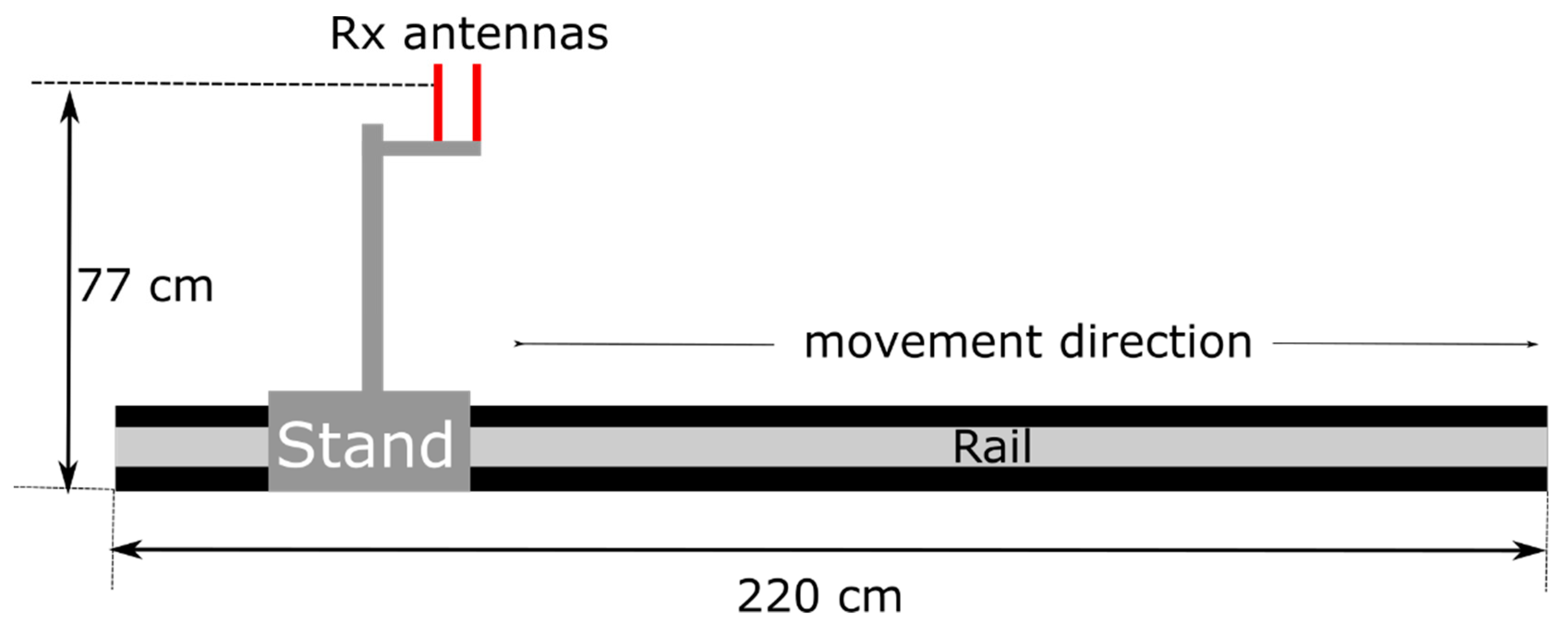
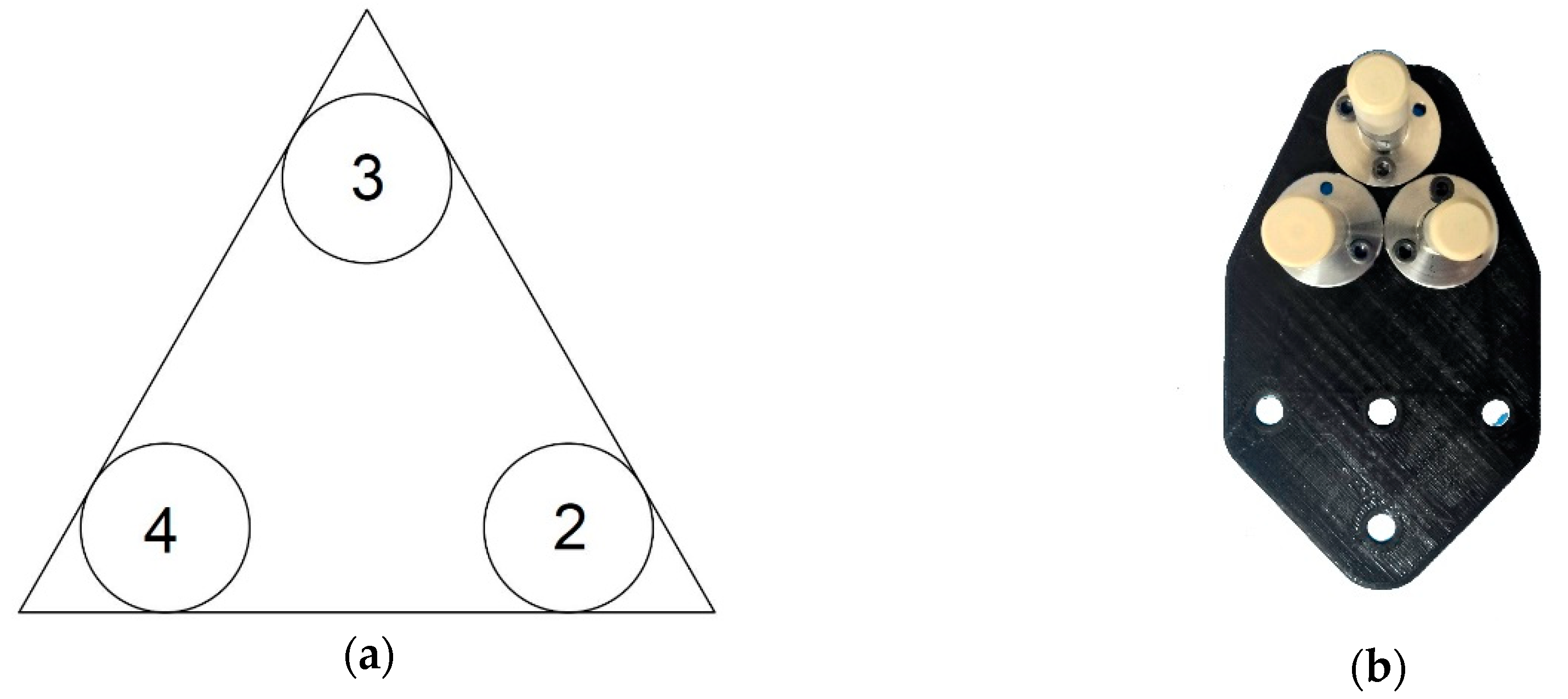
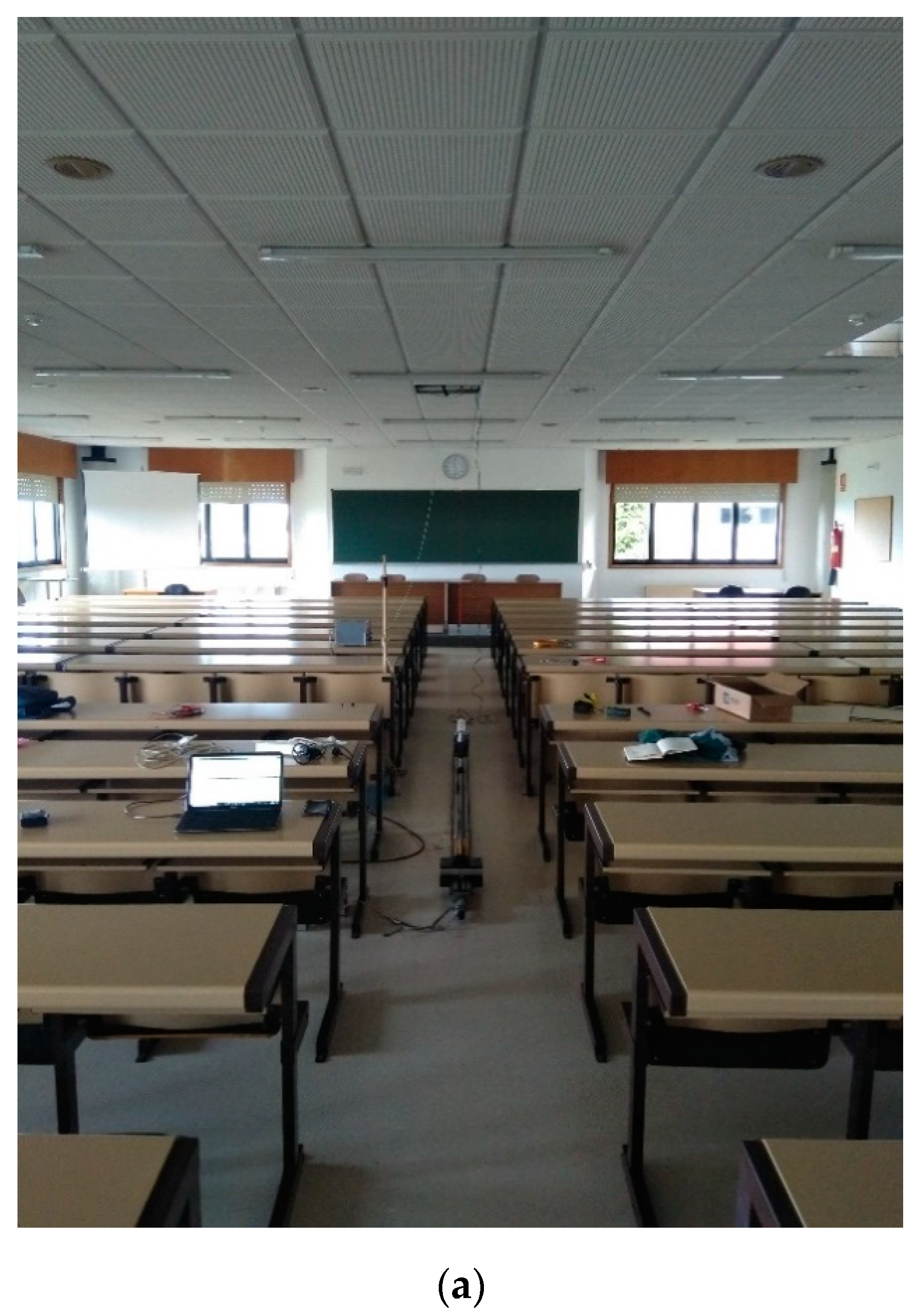
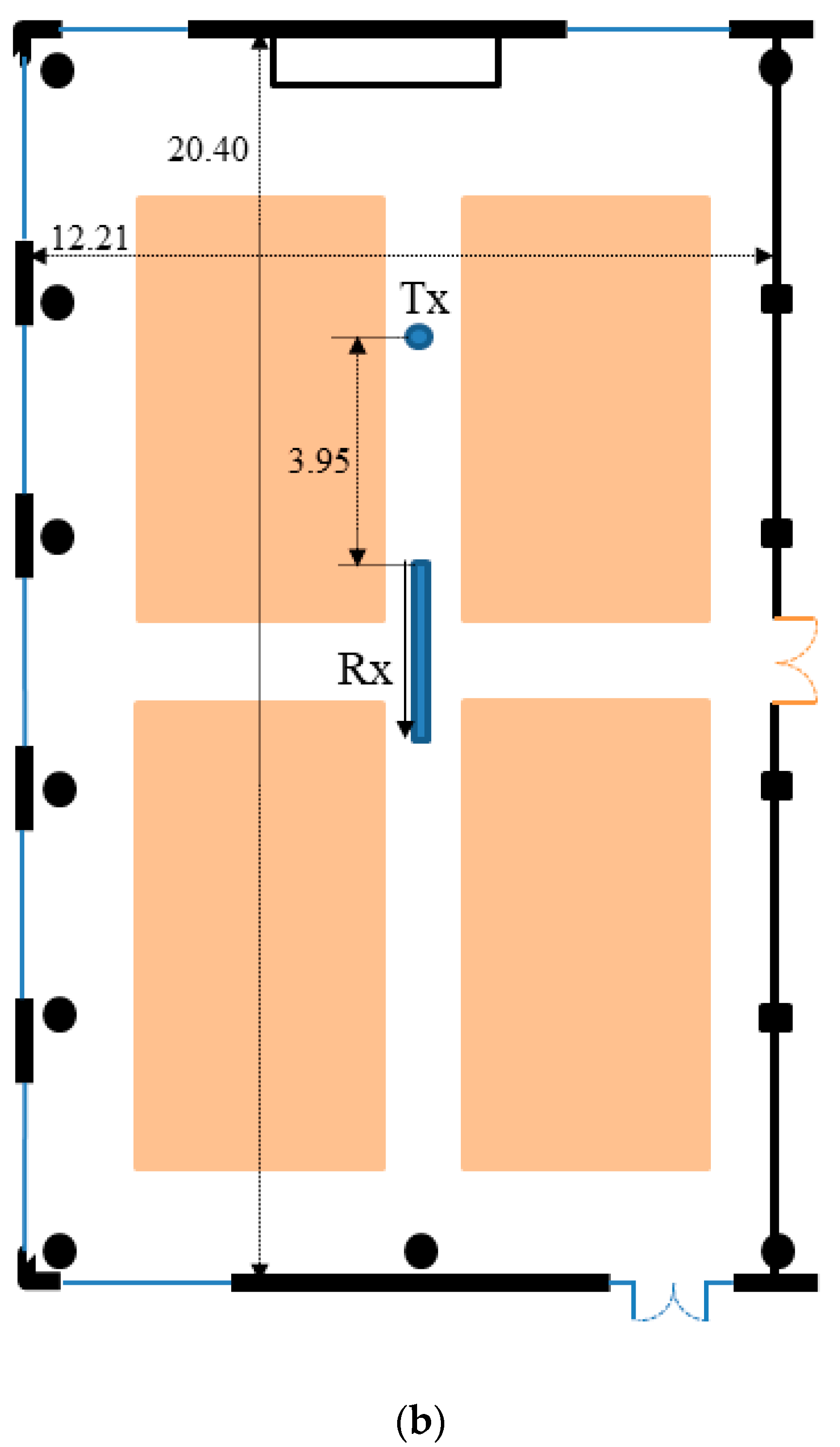
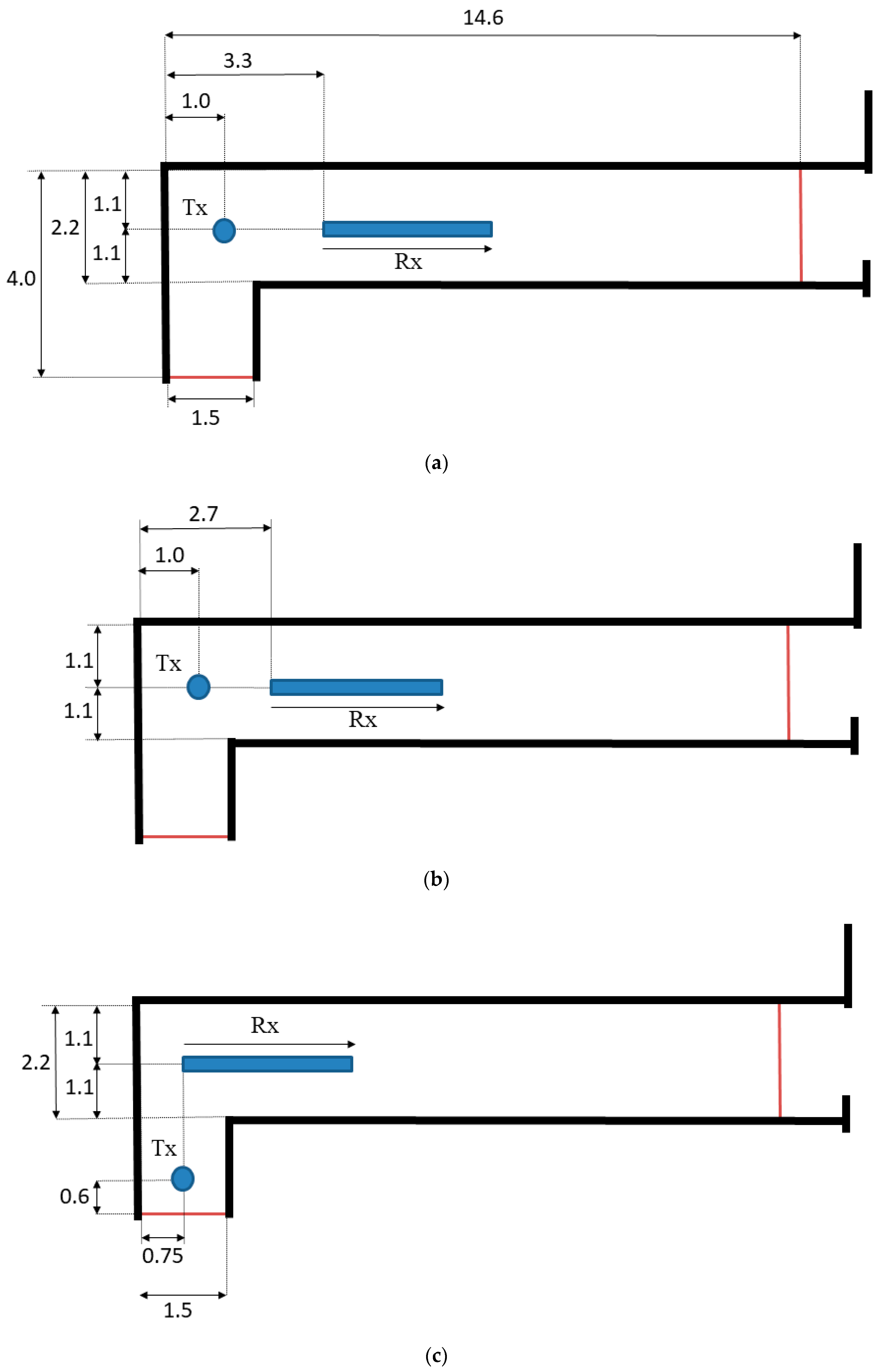
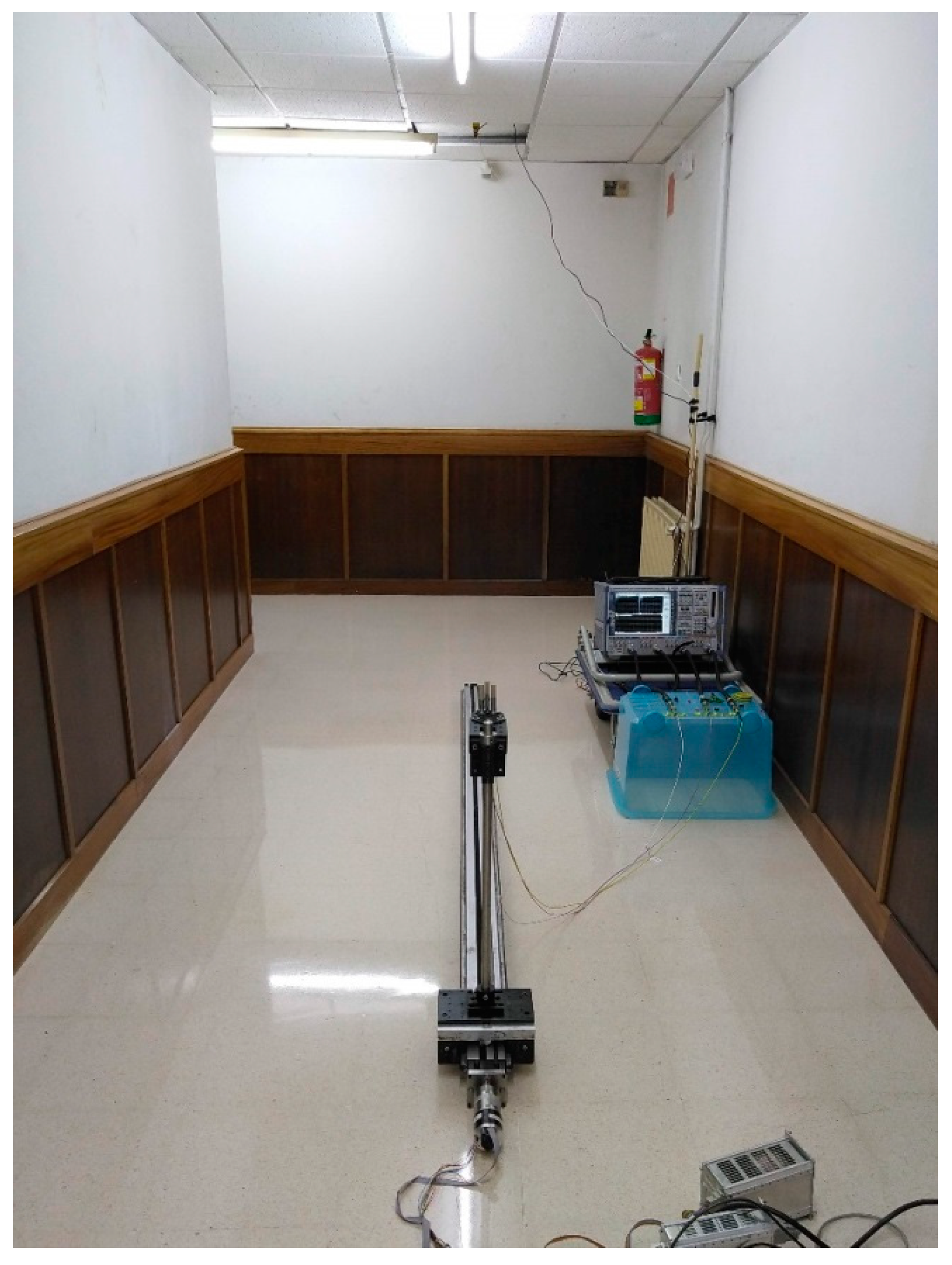

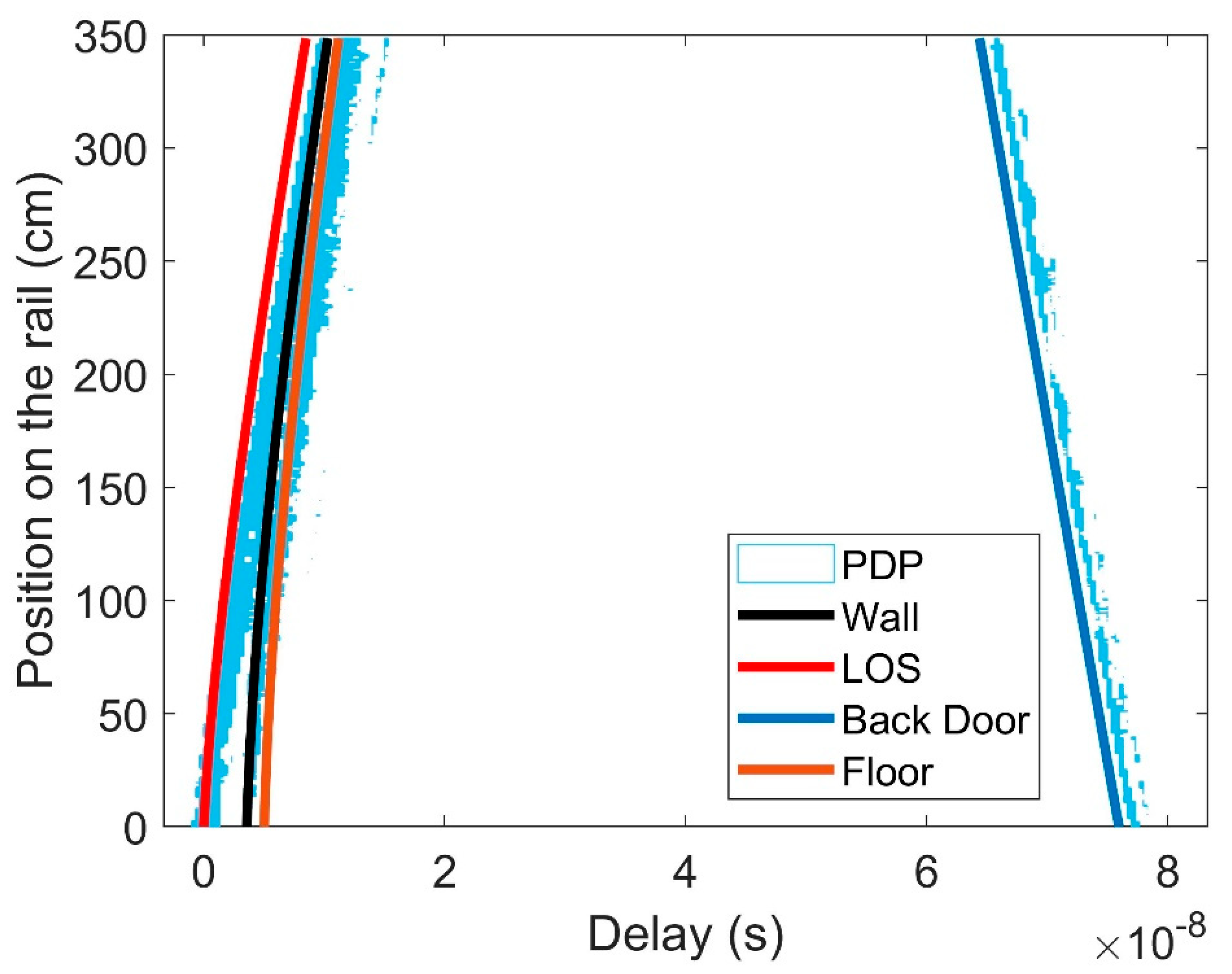
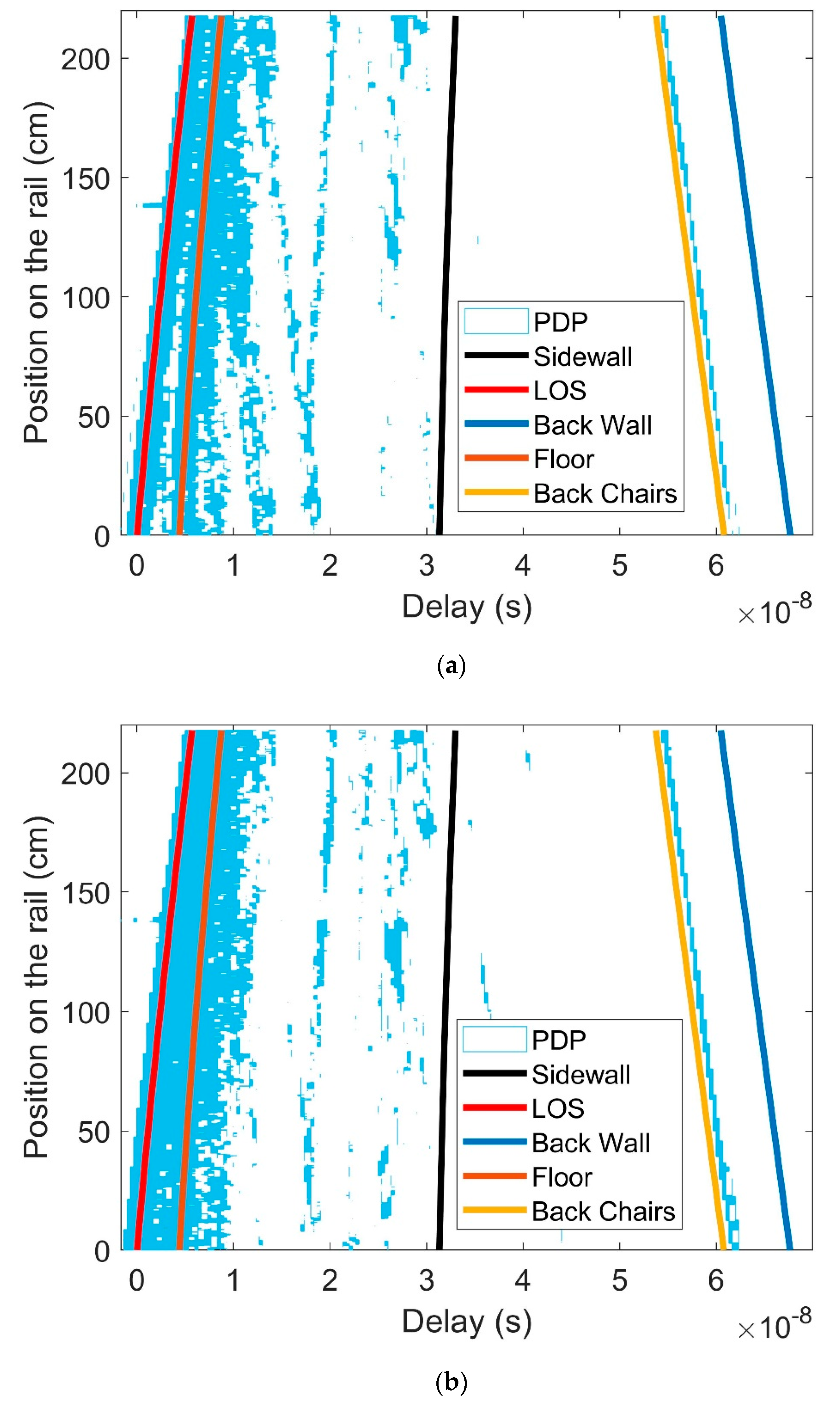
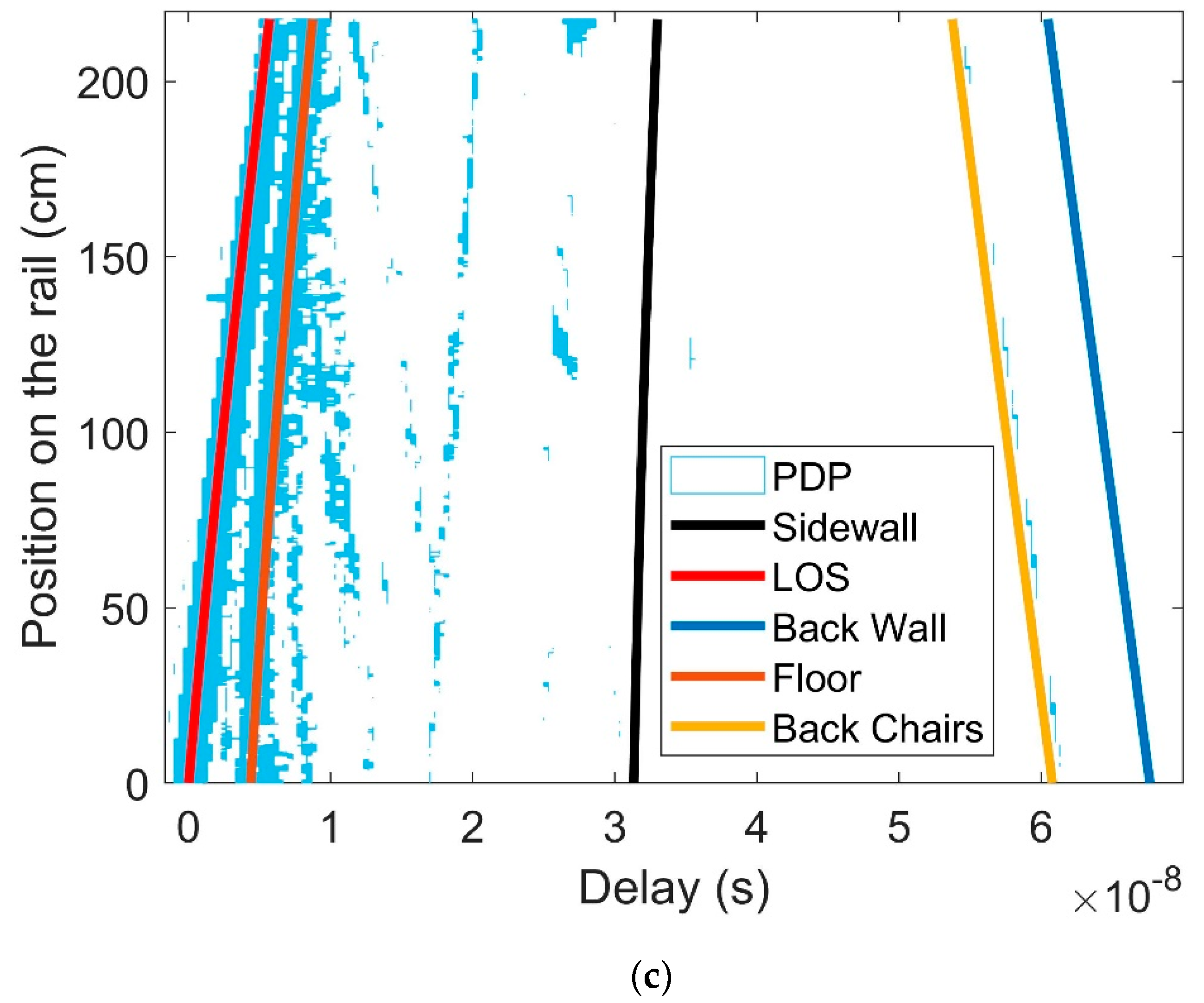
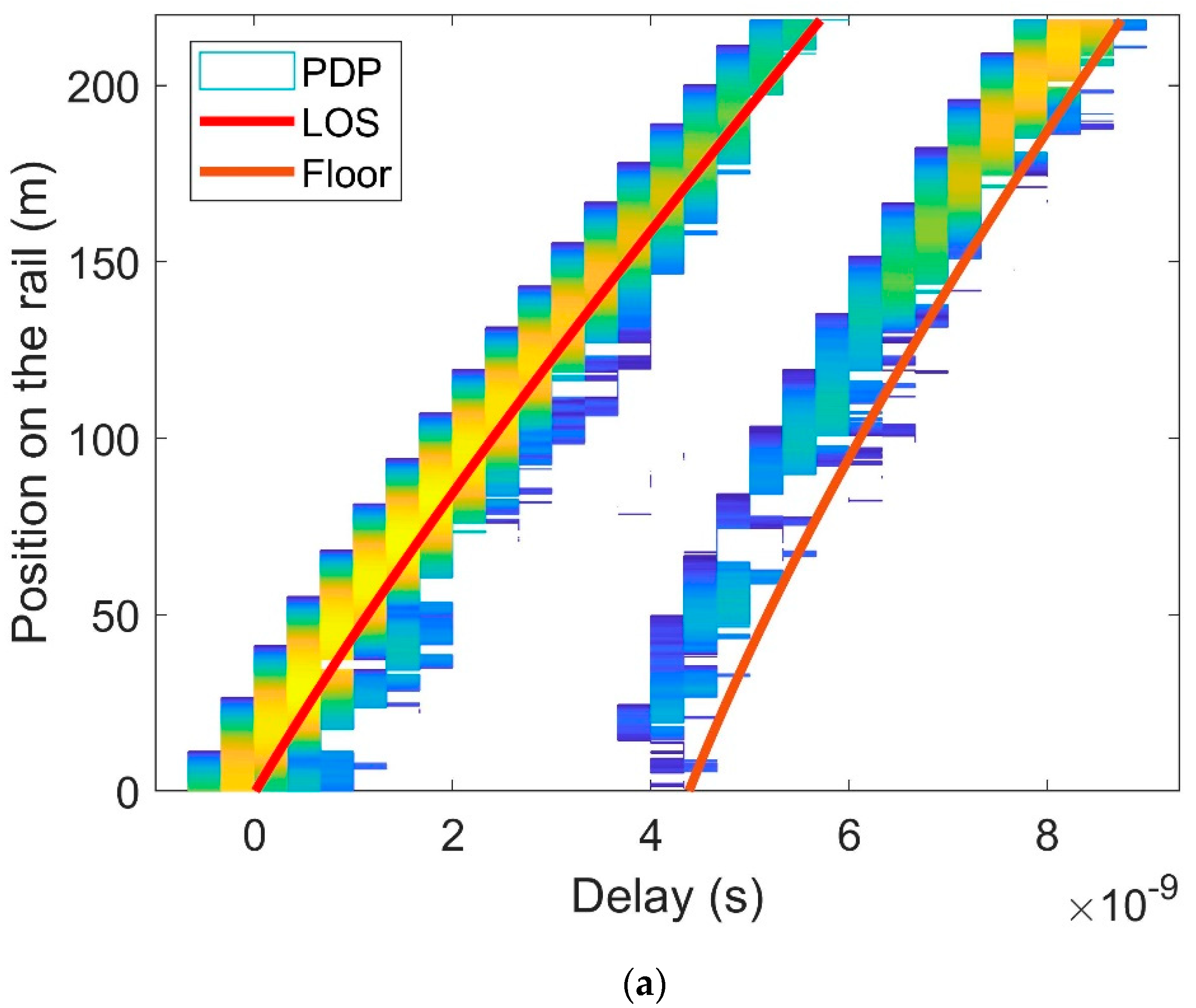
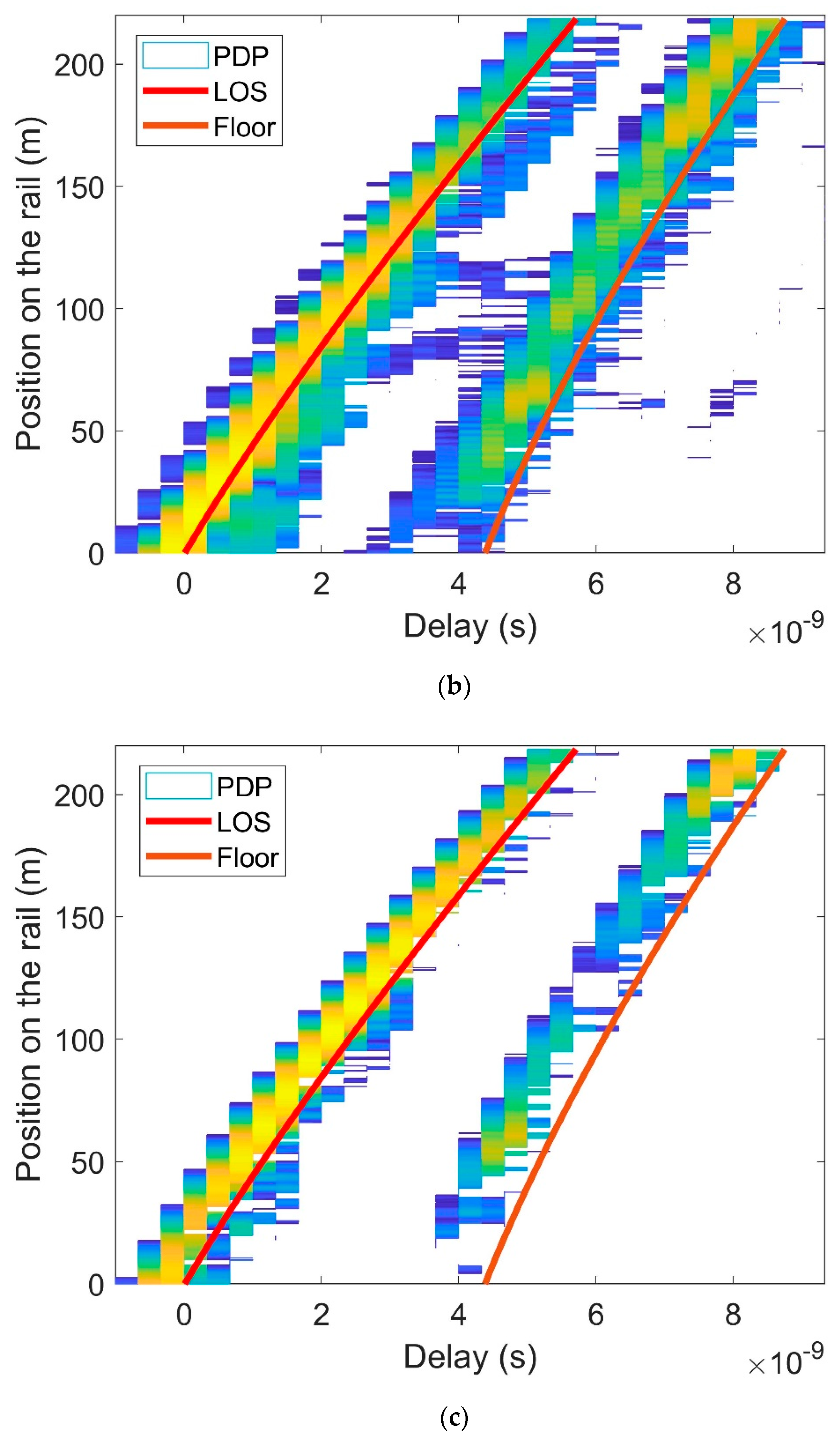
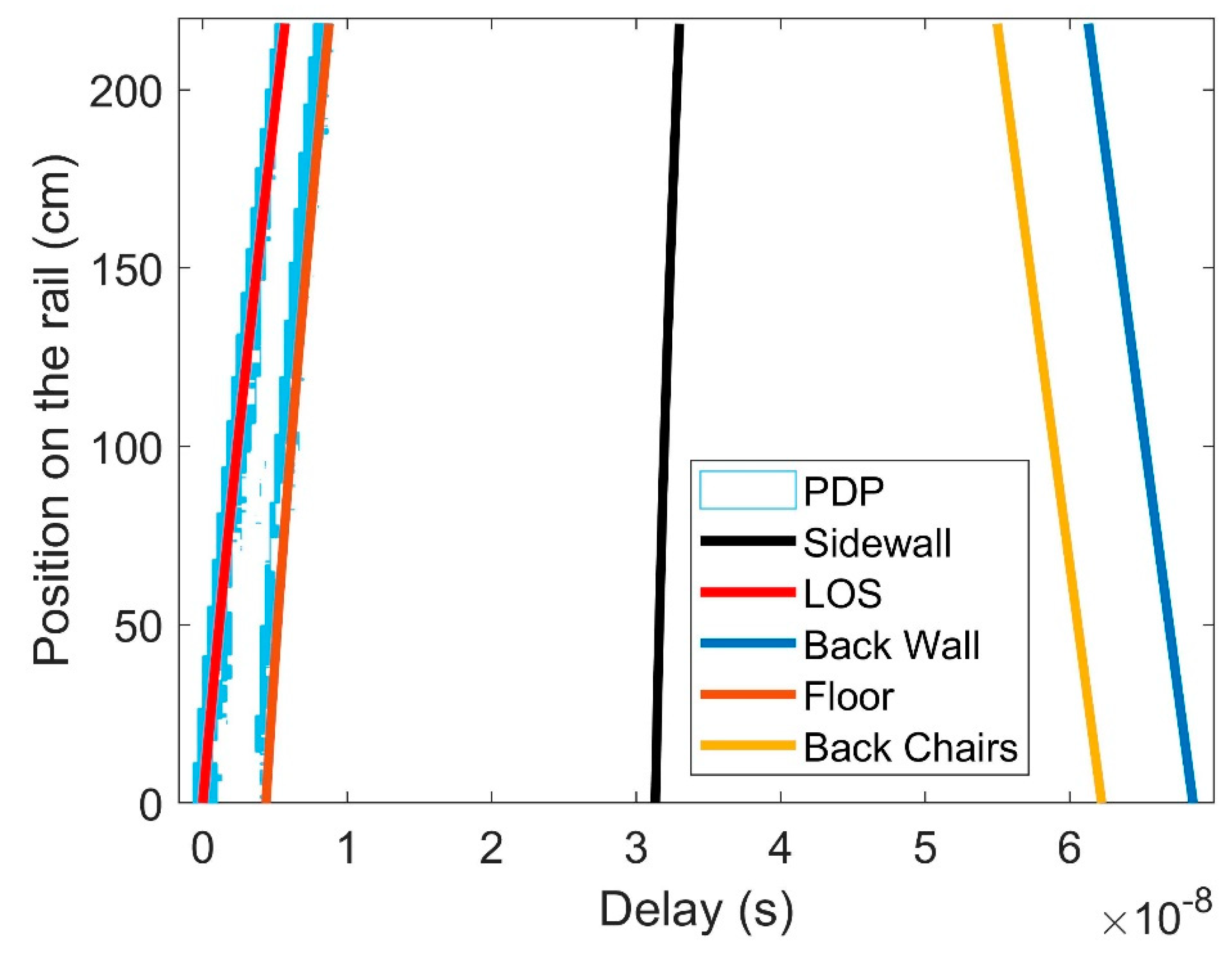
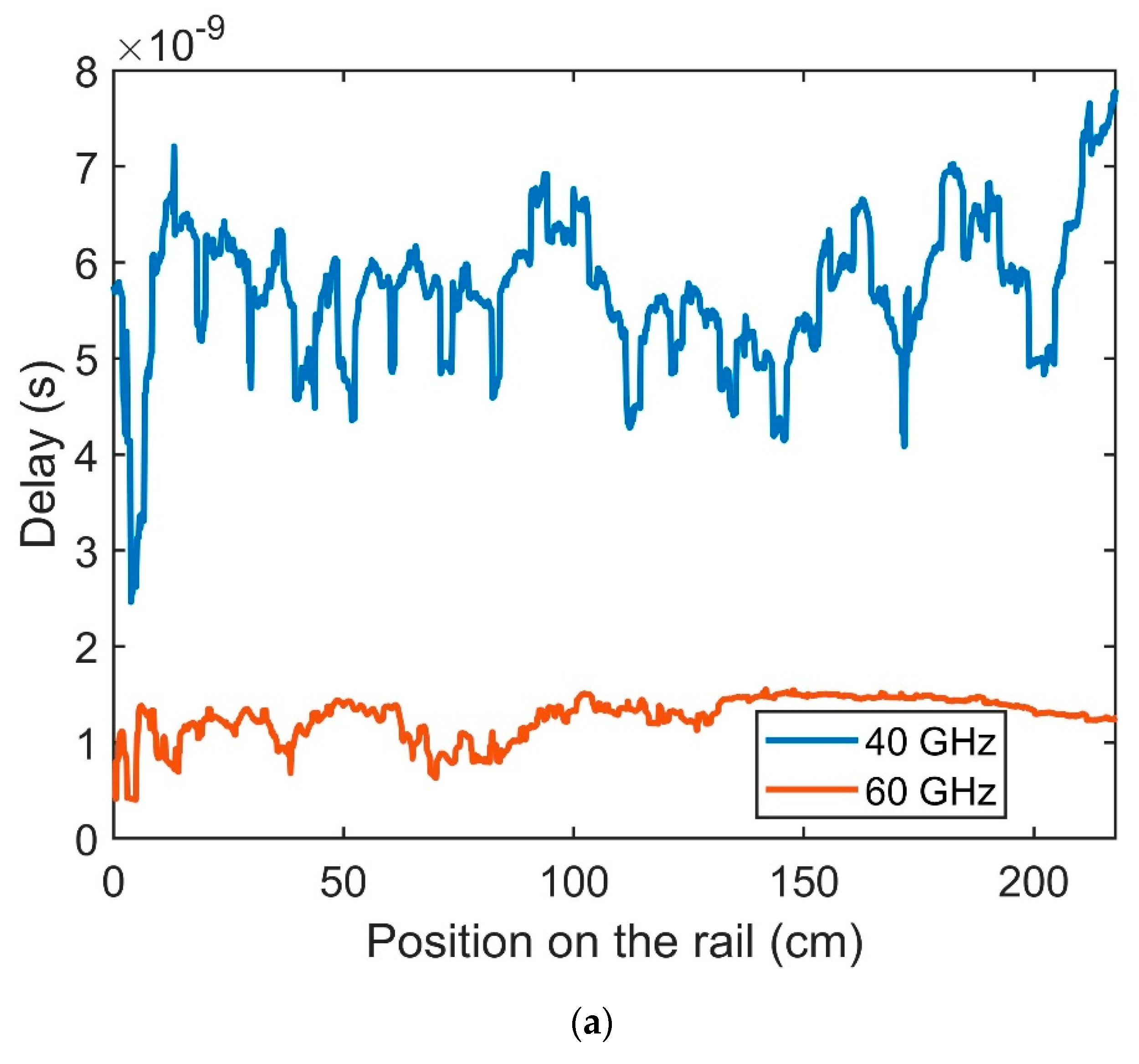
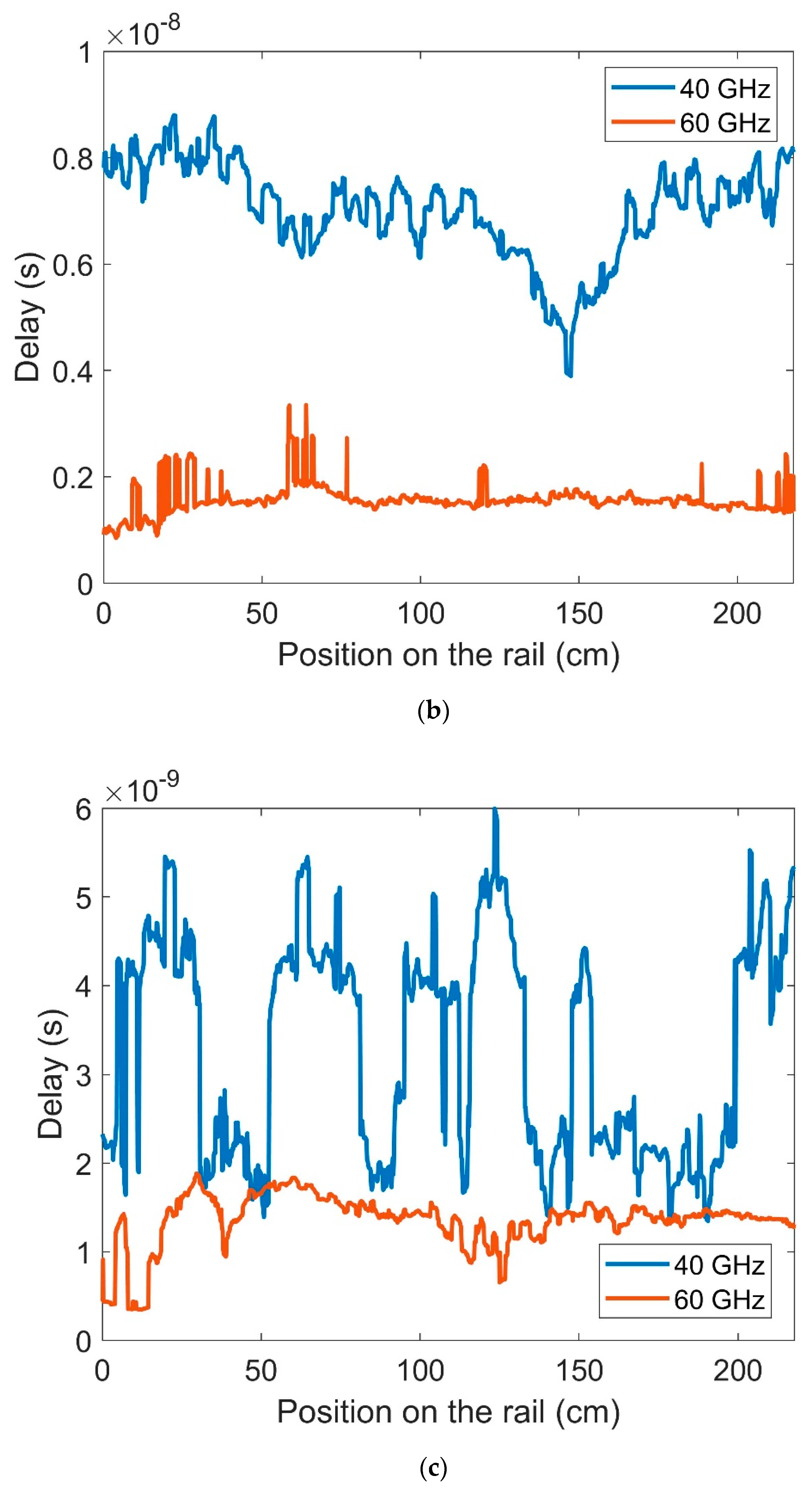
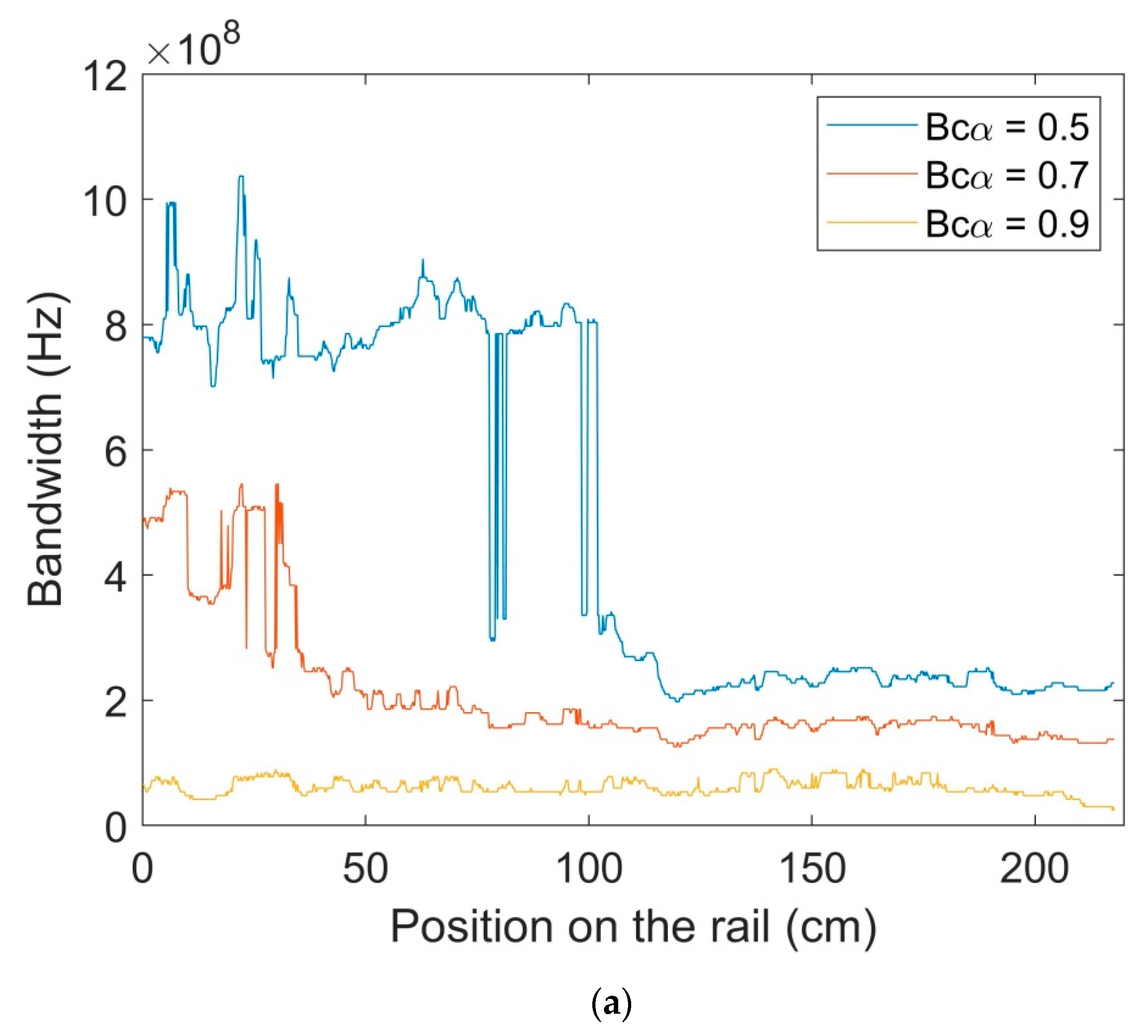
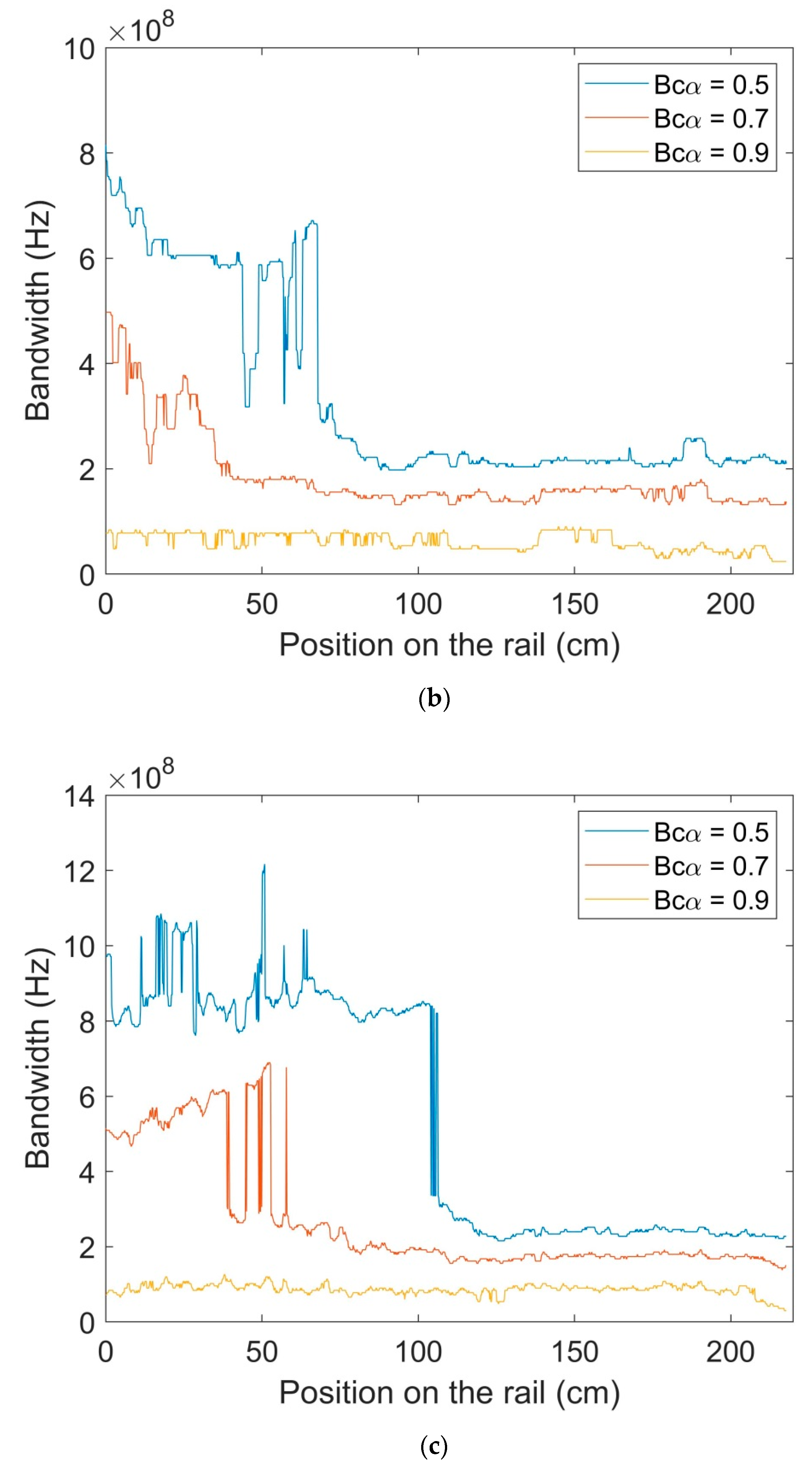
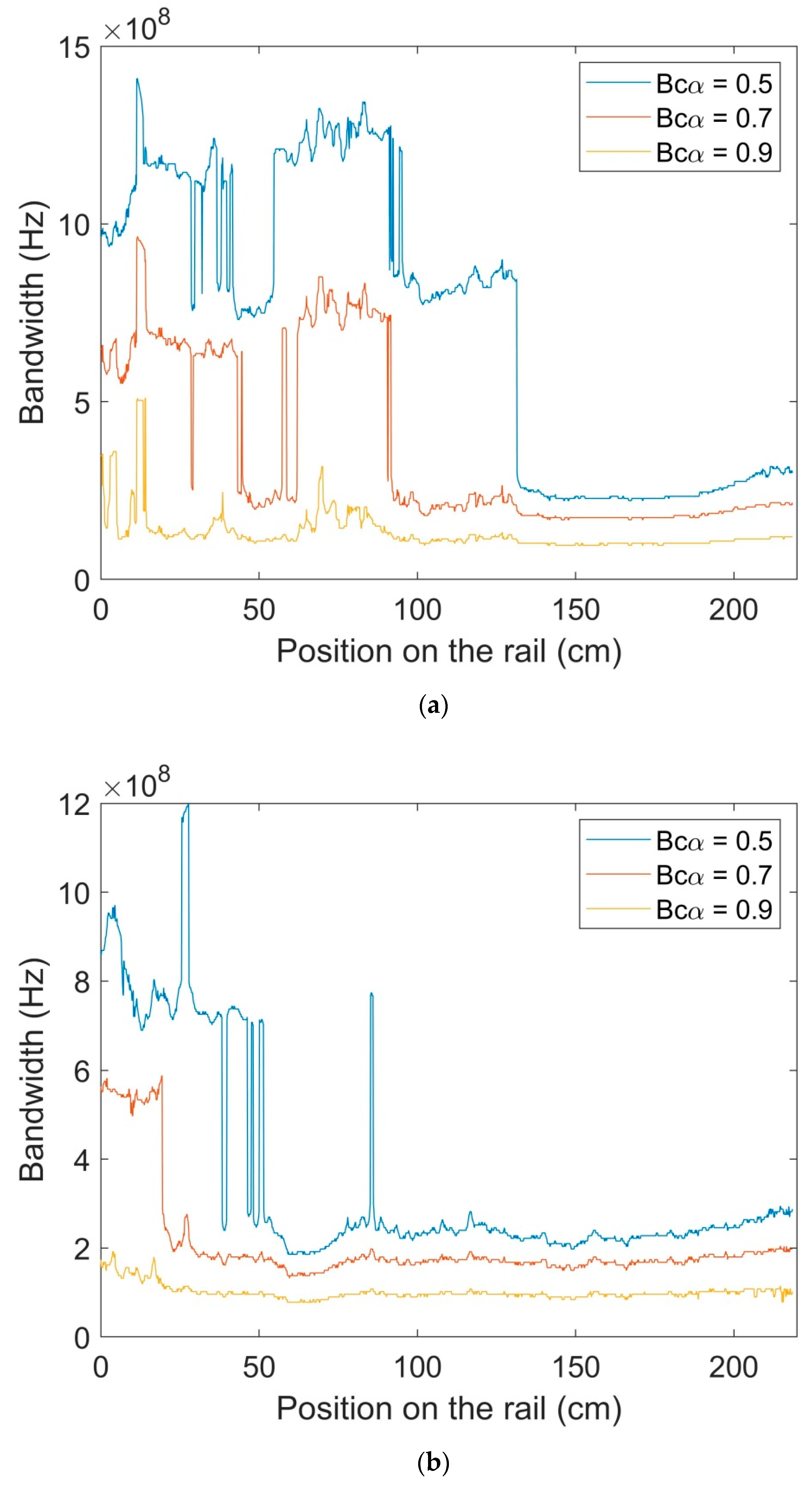
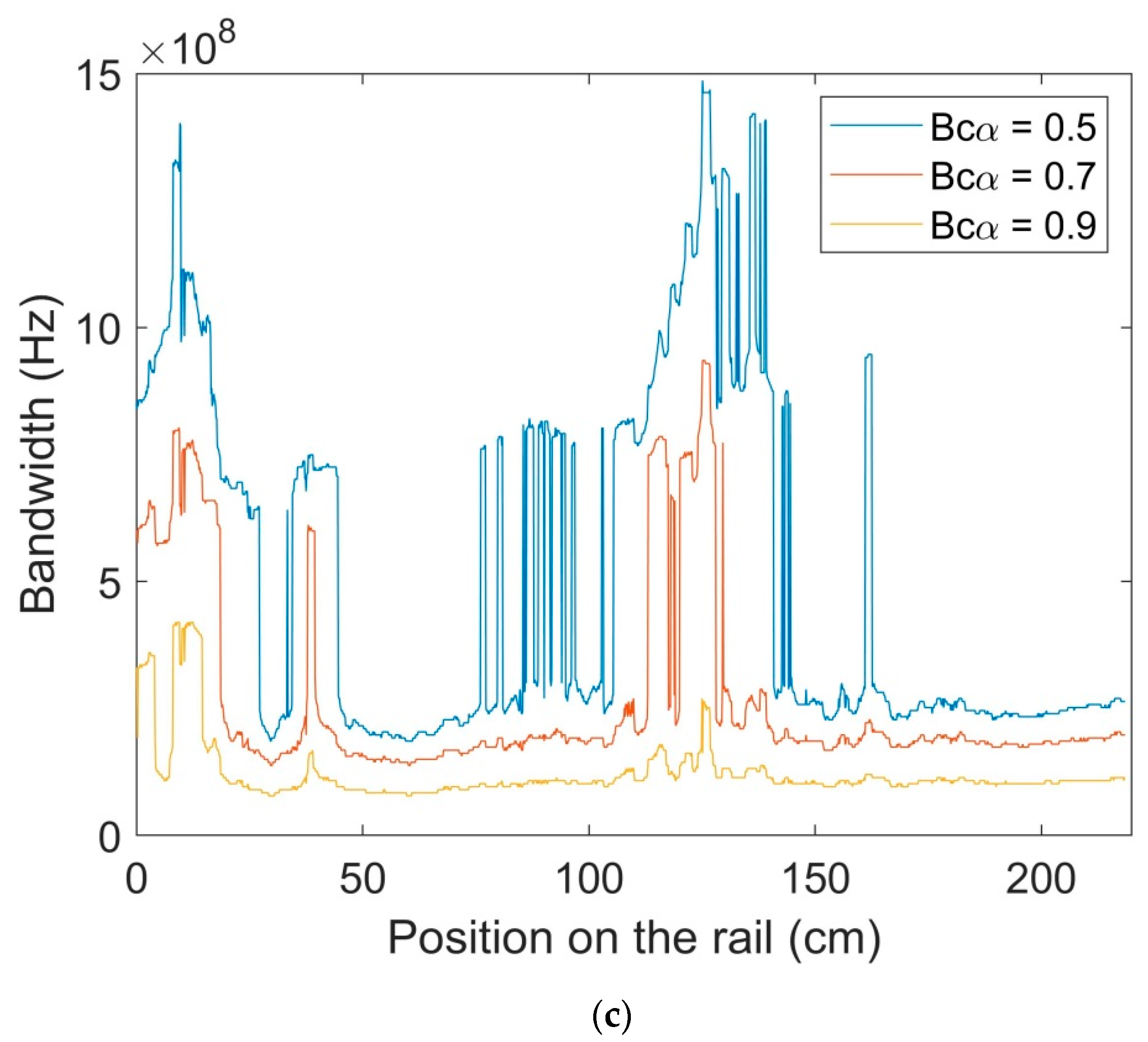
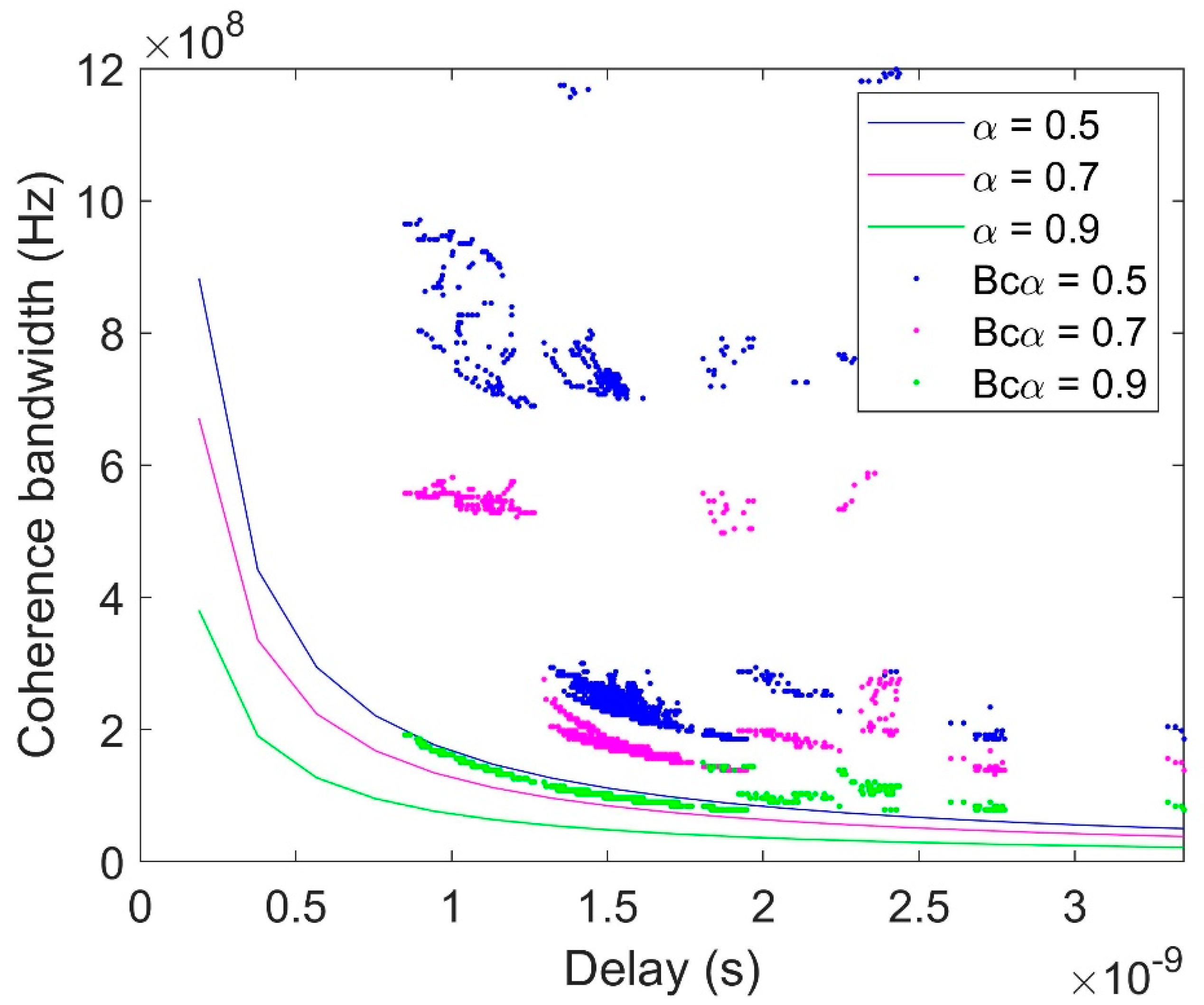
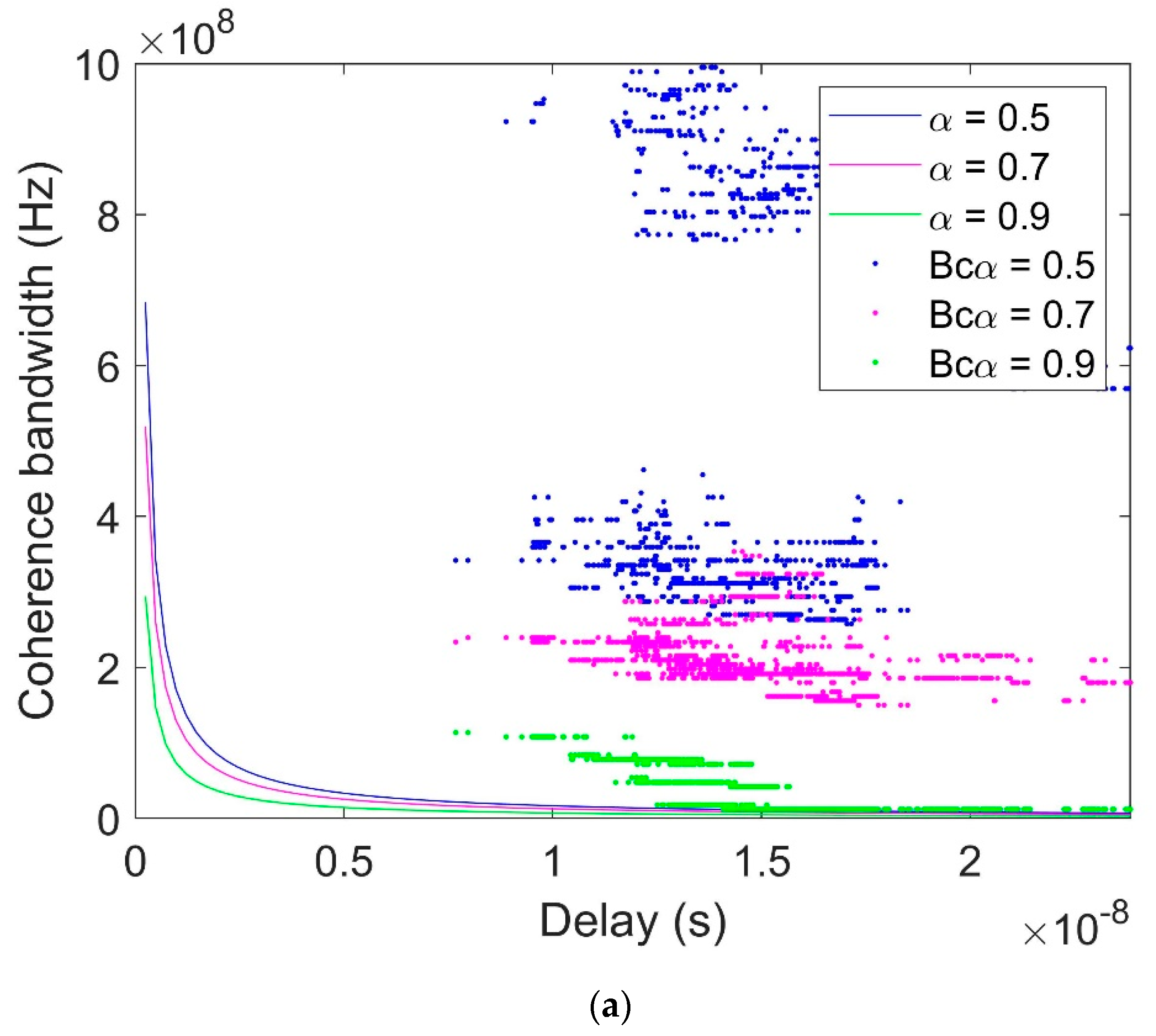
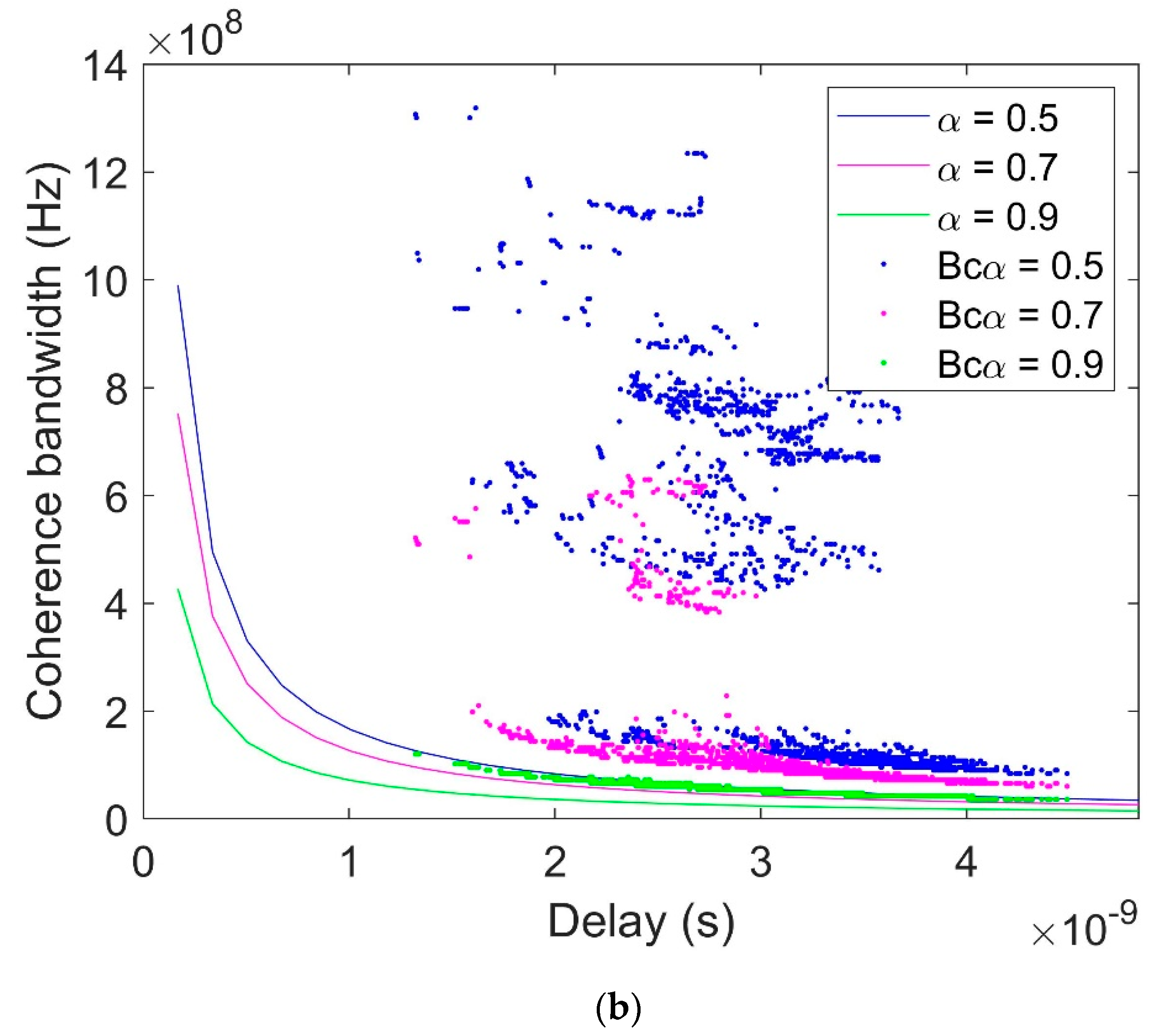
| Band | Received by Antenna “2” | Received by Antenna “3” | Received by Antenna “4” |
|---|---|---|---|
| 40 GHz | 7.46 | 8.64 | 5.43 |
| 60 GHz | 1.51 | 2.73 | 1.83 |
| Band | Correlation Level | Received by Antenna “2” | Received by Antenna “3” | Received by Antenna “4” |
|---|---|---|---|---|
| 40 GHz | 0.5 | 204 | 199 | 217 |
| 0.7 | 132 | 132 | 144 | |
| 0.9 | 30 | 24 | 36 | |
| 60 GHz | 0.5 | 222 | 186 | 192 |
| 0.7 | 168 | 138 | 144 | |
| 0.9 | 96 | 78 | 78 |
| Band | Channel 21 | Channel 31 | Channel 41 |
|---|---|---|---|
| 40 GHz | 7.4 | 8.4 | 5.4 |
| 60 GHz | 0.1 | 0.1 | 0.1 |
| Band | Channel 21 | Channel 31 | Channel 41 |
|---|---|---|---|
| 40 GHz | 6.9 | 8.4 | 8.7 |
| 60 GHz | 4.1 | 5.1 | 3.7 |
| Band | Correlation Level | Received by Antenna “2” | Received by Antenna “3” | Received by Antenna “4” |
|---|---|---|---|---|
| 40 GHz | 0.5 | 282 | 264 | 306 |
| 0.7 | 144 | 156 | 191 | |
| 0.9 | 12 | 12 | 12 | |
| 60 GHz | 0.5 | 209 | 179 | 227 |
| 0.7 | 48 | 18 | 12 | |
| 0.9 | 12 | 6 | 6 |
| Band | Correlation Level | Received by Antenna “2” | Received by Antenna “3” | Received by Antenna “4” |
|---|---|---|---|---|
| 40 GHz | 0.5 | 96 | 84 | 78 |
| 0.7 | 72 | 66 | 60 | |
| 0.9 | 4 | 4 | 4 | |
| 60 GHz | 0.5 | 126 | 108 | 120 |
| 0.7 | 96 | 84 | 90 | |
| 0.9 | 54 | 48 | 54 |
© 2019 by the authors. Licensee MDPI, Basel, Switzerland. This article is an open access article distributed under the terms and conditions of the Creative Commons Attribution (CC BY) license (http://creativecommons.org/licenses/by/4.0/).
Share and Cite
Riobó, M.; Hofman, R.; Cuiñas, I.; García Sánchez, M.; Verhaevert, J. Wideband Performance Comparison between the 40 GHz and 60 GHz Frequency Bands for Indoor Radio Channels. Electronics 2019, 8, 1234. https://doi.org/10.3390/electronics8111234
Riobó M, Hofman R, Cuiñas I, García Sánchez M, Verhaevert J. Wideband Performance Comparison between the 40 GHz and 60 GHz Frequency Bands for Indoor Radio Channels. Electronics. 2019; 8(11):1234. https://doi.org/10.3390/electronics8111234
Chicago/Turabian StyleRiobó, Miguel, Rob Hofman, Iñigo Cuiñas, Manuel García Sánchez, and Jo Verhaevert. 2019. "Wideband Performance Comparison between the 40 GHz and 60 GHz Frequency Bands for Indoor Radio Channels" Electronics 8, no. 11: 1234. https://doi.org/10.3390/electronics8111234
APA StyleRiobó, M., Hofman, R., Cuiñas, I., García Sánchez, M., & Verhaevert, J. (2019). Wideband Performance Comparison between the 40 GHz and 60 GHz Frequency Bands for Indoor Radio Channels. Electronics, 8(11), 1234. https://doi.org/10.3390/electronics8111234







